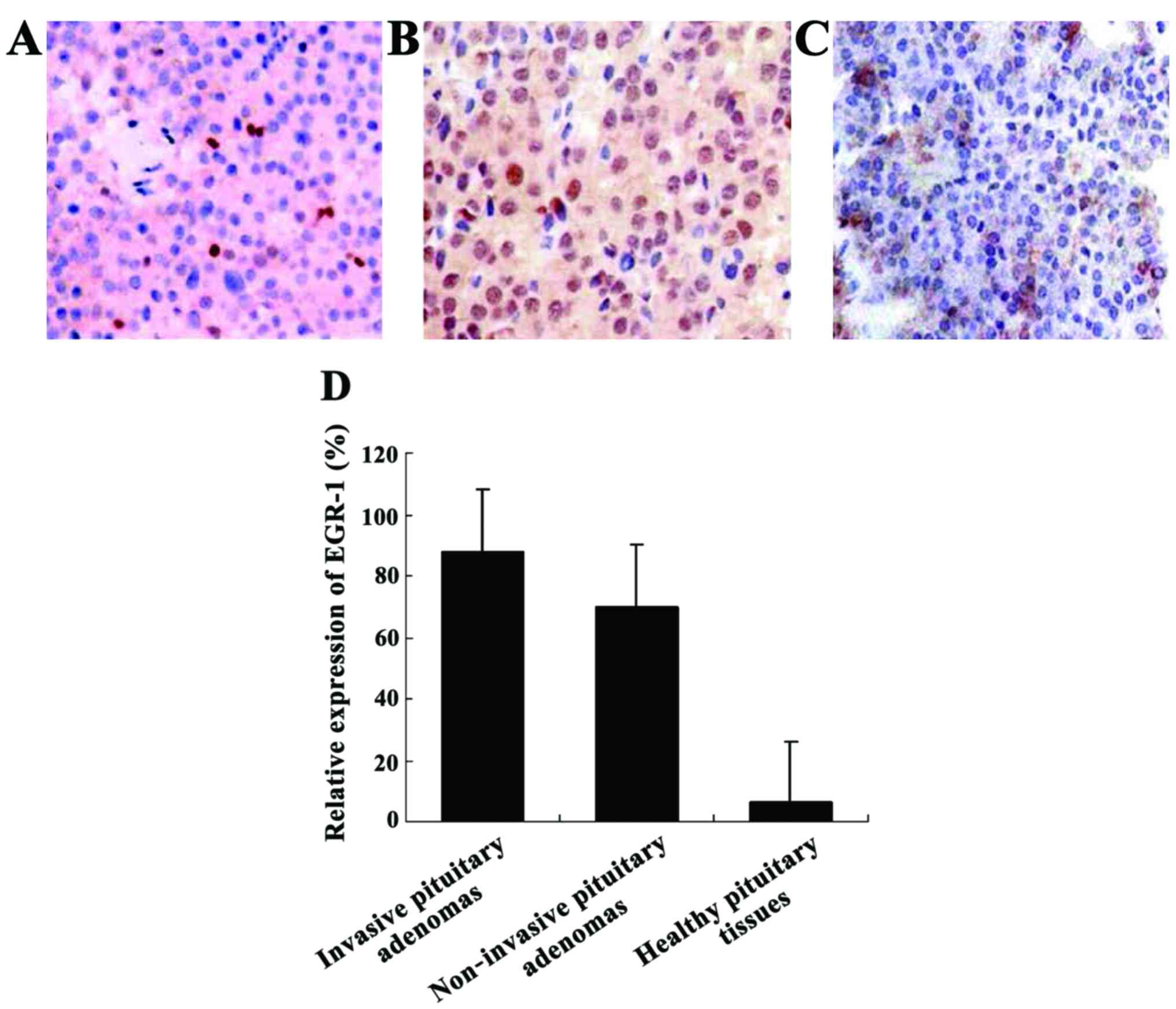|
1
|
Beckers A, Aaltonen LA, Daly AF and Karhu
A: Familial isolated pituitary adenomas (FIPA) and the pituitary
adenoma predisposition due to mutations in the aryl hydrocarbon
receptor interacting protein (AIP) gene. Endocr Rev. 34:239–277.
2013. View Article : Google Scholar : PubMed/NCBI
|
|
2
|
Donangelo I, Ren SG, Eigler T, Svendsen C
and Melmed S: Sca1+ murine pituitary adenoma cells show
tumor-growth advantage. Endocr Relat Cancer. 21:203–216. 2014.
View Article : Google Scholar : PubMed/NCBI
|
|
3
|
Zhu X, Wang Y, Zhao X, Jiang C, Zhang Q,
Jiang W, Wang Y, Chen H, Shou X, Zhao Y, et al: Incidence of
pituitary apoplexy and its risk factors in Chinese people: a
database study of patients with pituitary adenoma. PLoS One.
10:e01390882015. View Article : Google Scholar : PubMed/NCBI
|
|
4
|
Zhou Y, Zhang X and Klibanski A: Genetic
and epigenetic mutations of tumor suppressive genes in sporadic
pituitary adenoma. Mol Cell Endocrinol. 386:16–33. 2014. View Article : Google Scholar : PubMed/NCBI
|
|
5
|
Xiao JQ, Liu XH, Hou B, Yao Y, Deng K,
Feng M, Xing B, Lian W, Wang RZ and Feng F: Correlations of
pituitary tumor transforming gene expression with human pituitary
adenomas: a meta-analysis. PLoS One. 9:e903962014. View Article : Google Scholar : PubMed/NCBI
|
|
6
|
Cristina C, Luque GM, Demarchi G,
Lopez-Vicchi F, Zubeldia-Brenner L, Perez-Millan MI, Perrone S,
Ornstein AM, Lacau-Mengido IM, Berner SI, et al: Angiogenesis in
pituitary adenomas: human studies and new mutant mouse models. Int
J Endocrinol. 2014:6084972014. View Article : Google Scholar : PubMed/NCBI
|
|
7
|
Waligórska-Stachura J, Andrusiewicz M,
Sawicka-Gutaj N, Kubiczak M, Jankowska A, Liebert W, Czarnywojtek
A, Waśko R, Blanco-Gangoo AR and Ruchała M: Evaluation of survivin
splice variants in pituitary tumors. Pituitary. 18:410–416. 2015.
View Article : Google Scholar : PubMed/NCBI
|
|
8
|
Yang L, Tang J, Chen H, Ge D, Sui T, Que
J, Cao X and Ge Y: Taurine reduced epidural fibrosis in rat models
after laminectomy via downregulating EGR1. Cell Physiol Biochem.
38:2261–2271. 2016. View Article : Google Scholar : PubMed/NCBI
|
|
9
|
Fekete C and Lechan RM: Central regulation
of hypothalamic- pituitary-thyroid axis under physiological and
pathophysiological conditions. Endocr Rev. 35:159–194. 2014.
View Article : Google Scholar : PubMed/NCBI
|
|
10
|
Gaston-Massuet C, Andoniadou CL, Signore
M, Jayakody SA, Charolidi N, Kyeyune R, Vernay B, Jacques TS,
Taketo MM, Le Tissier P, et al: Increased Wingless (Wnt) signaling
in pituitary progenitor/stem cells gives rise to pituitary tumors
in mice and humans. Proc Natl Acad Sci USA. 108:pp. 11482–11487.
2011; View Article : Google Scholar : PubMed/NCBI
|
|
11
|
Miermeister CP, Petersenn S, Buchfelder M,
Fahlbusch R, Lüdecke DK, Hölsken A, Bergmann M, Knappe HU, Hans VH,
Flitsch J, et al: Histological criteria for atypical pituitary
adenomas - data from the German pituitary adenoma registry suggests
modifications. Acta Neuropathol Commun. 3:502015. View Article : Google Scholar : PubMed/NCBI
|
|
12
|
Heaney AP: Clinical review: pituitary
carcinoma: difficult diagnosis and treatment. J Clin Endocrinol
Metab. 96:3649–3660. 2011. View Article : Google Scholar : PubMed/NCBI
|
|
13
|
Mathioudakis N, Sundaresh R, Larsen A,
Ruff W, Schiller J, Guerrero-Cázares H, Burger P, Salvatori R and
Quiñones-Hinojosa A: Expression of the pituitary stem/progenitor
marker GFRα2 in human pituitary adenomas and normal pituitary.
Pituitary. 18:31–41. 2015. View Article : Google Scholar : PubMed/NCBI
|
|
14
|
Lines KE, Stevenson M and Thakker RV:
Animal models of pituitary neoplasia. Mol Cell Endocrinol.
421:68–81. 2016. View Article : Google Scholar : PubMed/NCBI
|
|
15
|
Antoine V, Moret C, Schmitt E, Klein M and
Bracard S: MRI imaging of the neural pituitary. Ann Endocrinol
(Paris). 69:181–192. 2008.(In French). View Article : Google Scholar : PubMed/NCBI
|
|
16
|
Komotar RJ, Starke RM, Raper DM, Anand VK
and Schwartz TH: Endoscopic endonasal compared with microscopic
transsphenoidal and open transcranial resection of giant pituitary
adenomas. Pituitary. 15:150–159. 2012. View Article : Google Scholar : PubMed/NCBI
|
|
17
|
Birt JA, Nabli H, Stilley JA, Windham EA,
Frazier SR and Sharpe-Timms KL: Elevated peritoneal fluid TNF-α
incites ovarian early growth response factor 1 expression and
downstream protease mediators: a correlation with ovulatory
dysfunction in endometriosis. Reprod Sci. 20:514–523. 2013.
View Article : Google Scholar : PubMed/NCBI
|
|
18
|
Palumbo T, Faucz FR, Azevedo M, Xekouki P,
Iliopoulos D and Stratakis CA: Functional screen analysis reveals
miR-26b and miR-128 as central regulators of pituitary
somatomammotrophic tumor growth through activation of the PTEN-AKT
pathway. Oncogene. 32:1651–1659. 2013. View Article : Google Scholar : PubMed/NCBI
|
|
19
|
Tornesello ML, Annunziata C, Buonaguro L,
Losito S, Greggi S and Buonaguro FM: TP53 and PIK3CA gene mutations
in adenocarcinoma, squamous cell carcinoma and high-grade
intraepithelial neoplasia of the cervix. J Transl Med. 12:2552014.
View Article : Google Scholar : PubMed/NCBI
|
|
20
|
Burgucu D, Guney K, Sahinturk D, Ozbudak
IH, Ozel D, Ozbilim G and Yavuzer U: Tbx3 represses PTEN and is
over- expressed in head and neck squamous cell carcinoma. BMC
Cancer. 12:4812012. View Article : Google Scholar : PubMed/NCBI
|
|
21
|
Ozen E, Gozukizil A, Erdal E, Uren A,
Bottaro DP and Atabey N: Heparin inhibits hepatocyte growth factor
induced motility and invasion of hepatocellular carcinoma cells
through early growth response protein 1. PLoS One. 7:e427172012.
View Article : Google Scholar : PubMed/NCBI
|
|
22
|
Mellotte G, Maher V, Devitt PG, Shin VY
and Leung CP: Minimally invasive surgical oncology: state of the
art. Asian Pac J Surg Oncol. 1:101–112. 2015.
|
|
23
|
He J, Yu JJ, Xu Q, Wang L, Zheng JZ, Liu
LZ and Jiang BH: Downregulation of ATG14 by EGR1-MIR152 sensitizes
ovarian cancer cells to cisplatin-induced apoptosis by inhibiting
cyto-protective autophagy. Autophagy. 11:373–384. 2015. View Article : Google Scholar : PubMed/NCBI
|












